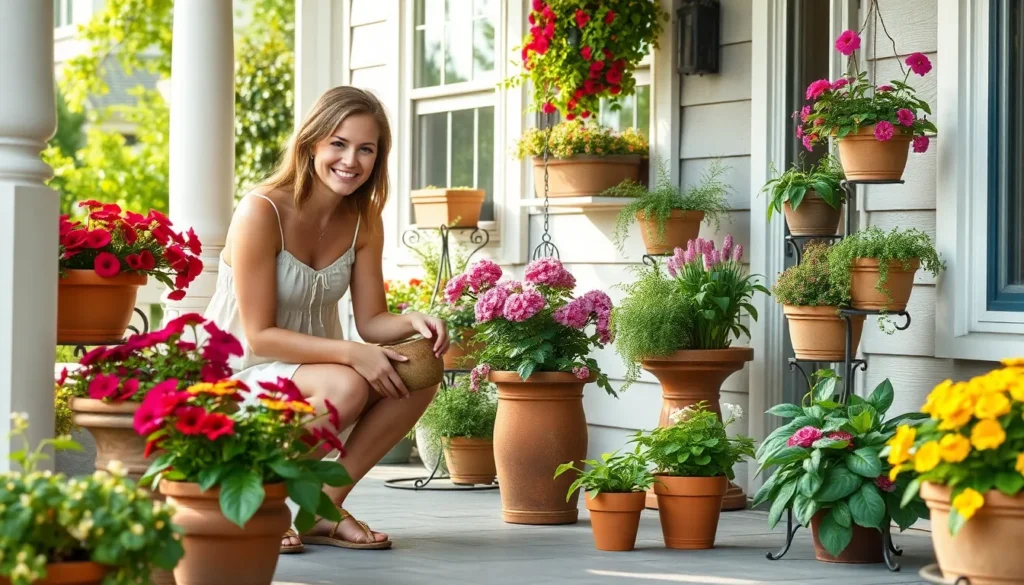Front porches aren’t just entrances – they’re opportunities to create stunning first impressions that welcome guests and boost your home’s curb appeal. Whether you’re working with a sprawling wraparound porch or a cozy stoop, the right garden design can transform this overlooked space into your home’s crown jewel.
We’ve discovered that front porch gardens offer unique advantages over traditional landscaping. They’re easier to maintain, provide instant visual impact, and create that coveted indoor-outdoor living experience that today’s homeowners crave. From cascading hanging baskets to strategic container arrangements, these gardens work harder than any other landscaping investment.
The best part? You don’t need a green thumb or extensive gardening experience to create a show-stopping front porch garden. With the right plant selections and design principles, we’ll show you how to create a welcoming entrance that reflects your personal style while thriving in your exact climate conditions.
Container Gardens That Welcome Guests
Container gardens offer the perfect solution for creating welcoming front porch displays that greet visitors with style and charm. We can transform any porch space into an inviting garden oasis using strategic container arrangements.
Colorful Planters and Pots
Bright ceramic planters create instant focal points that draw the eye and establish your porch’s personality. We recommend choosing containers in vibrant blues, sunny yellows, or classic terracotta to complement your home’s exterior colors. Large planters work best for statement pieces like dwarf citrus trees, ornamental grasses, or flowering shrubs such as hydrangeas and azaleas.
Mixed container groupings add visual depth when we combine different sizes and heights together. Place three to five planters of varying dimensions near your front door, using the “thriller, filler, spiller” planting technique. Tall plants like coleus or caladiums serve as thrillers, while petunias or impatiens fill the middle space, and trailing ivy or sweet potato vines spill gracefully over the edges.
Weather resistant materials ensure longevity through seasonal changes and daily wear. Fiberglass, resin, and glazed ceramic containers withstand temperature fluctuations better than basic terracotta or wooden planters. We suggest investing in quality containers that’ll maintain their appearance for years while protecting your plant investments.
Tiered Plant Stands
Multi level plant stands maximize vertical space on smaller porches where floor space is limited. We can display 6 to 12 plants on a single tiered stand, creating an impressive garden wall effect. Wrought iron, wooden, or bamboo stands complement different architectural styles while providing sturdy support for multiple containers.
Strategic plant placement creates visual balance when we arrange taller specimens on lower tiers and shorter plants on upper levels. This reverse pyramid approach ensures every plant receives adequate sunlight while creating an appealing silhouette. Flowering plants like geraniums, begonias, and marigolds shine on upper tiers where their blooms are most visible.
Corner placement optimizes awkward spaces that often go unused on front porches. We position tiered stands in corners to soften harsh angles while creating cozy garden nooks. These arrangements work particularly well with climbing plants like morning glories or clematis that can trail up porch columns or railings.
Hanging Basket Arrangements
Overhead baskets frame entryways beautifully when suspended from porch ceilings or sturdy brackets. We recommend hanging baskets 6 to 8 feet above ground level to ensure adequate clearance for guests while creating an enchanting canopy effect. Coconut fiber, wire, or decorative metal baskets provide different aesthetic options.
Cascading flowers soften architectural lines with their natural flowing movement in gentle breezes. Trailing petunias, lobelia, and bacopa create stunning waterfall effects that draw attention upward. We plant 3 to 5 plants per 12 inch basket for full, lush coverage that develops within 4 to 6 weeks.
Seasonal rotation keeps displays fresh throughout the growing season as we swap out spent blooms for new varieties. Spring baskets might feature pansies and primrose, while summer arrangements showcase impatiens and begonias. Fall displays can incorporate trailing mums and ornamental kale for continued color into cooler months.
Vertical Growing Solutions for Small Spaces
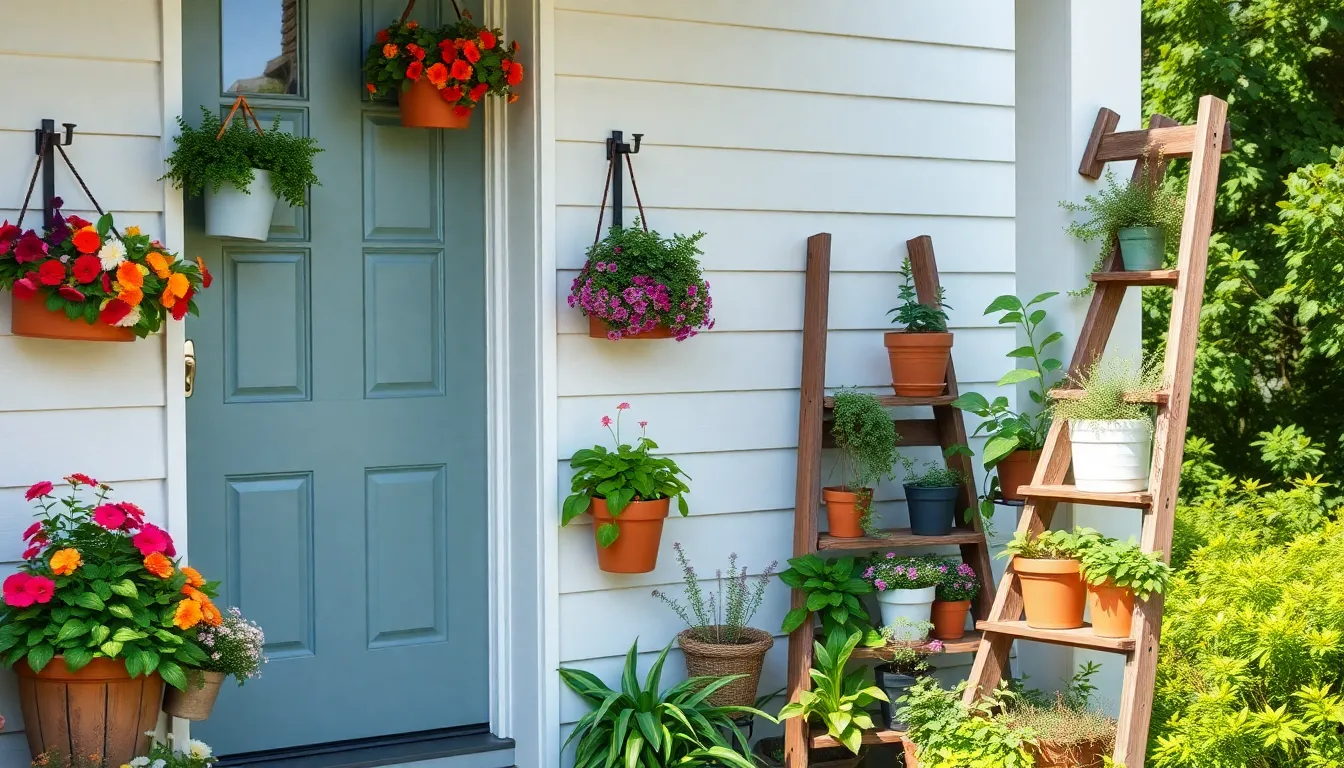
When porch real estate is limited, growing upward transforms cramped spaces into flourishing garden displays. Smart vertical answers maximize every square inch while creating the layered depth that makes small porches feel more spacious.
Wall-Mounted Planters
Wall-mounted planters use vertical wall space without sacrificing precious floor area on your front porch. These space-saving answers hold everything from aromatic herbs to colorful flowers, keeping your garden organized and easily accessible. Terra-cotta pots arranged in tiered formations create vibrant displays that draw the eye upward and add visual interest to blank porch walls.
Mounting planters at varying heights establishes a cascading effect that feels natural and unforced. Choose planters that complement your porch’s architectural style while ensuring they’re securely fastened to handle the weight of soil and plants. We recommend selecting drought-tolerant plants for wall-mounted displays since they tend to dry out faster than ground-level containers.
Trellises and Climbing Plants
Trellises transform empty porch walls into living green screens using climbing plants that grow vertically rather than spreading outward. Install these structures near railings or directly on porch walls to support vines like sweet peas, morning glories, or climbing roses. An arched trellis covered with flowering vines becomes a stunning focal point that frames your entrance beautifully.
Climbing plants require proper spacing to ensure adequate airflow and prevent overcrowding issues. Select fast-growing varieties for quick coverage, or choose perennial climbers for long-term garden structure. Position trellises where they’ll receive appropriate sunlight for your chosen plants while considering how mature growth will affect your porch’s lighting.
Ladder Plant Displays
Ladder-style plant stands create impressive vertical gardens that showcase multiple plants in a compact footprint. These tiered displays add height and dimension to small porches while allowing you to feature various plant types at different levels. Repurpose vintage wooden ladders or invest in purpose-built plant stands that accommodate standard-sized pots.
Arrange plants by height and light requirements, placing sun-loving varieties at the top and shade-tolerant plants lower down. Mix textures and colors throughout the display to create visual movement that guides visitors’ eyes from ground level to your porch ceiling. We suggest securing ladder displays to prevent tipping, especially in windy conditions.
Seasonal Flower Displays That Rotate Year-Round
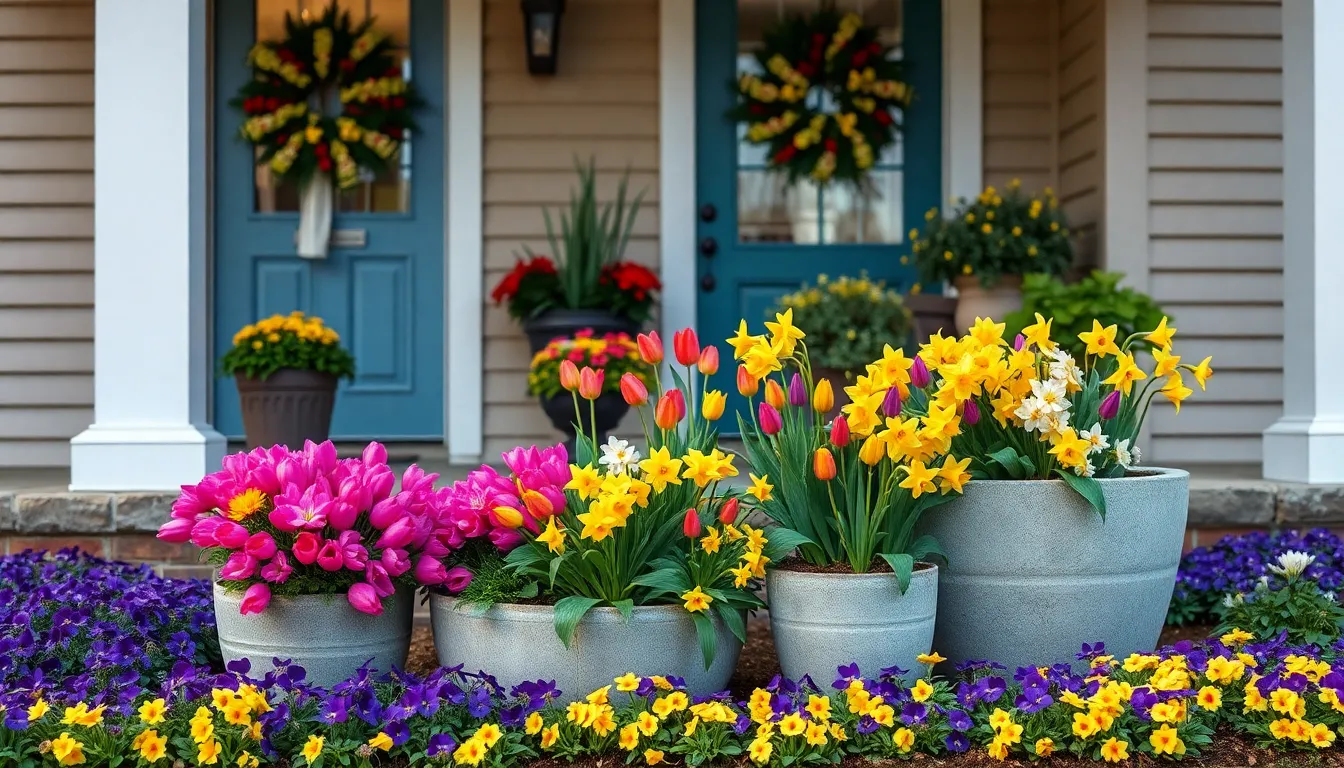
Creating a front porch garden that evolves with the seasons keeps your entrance looking fresh and vibrant all year long. We’ll explore how to design rotating displays that celebrate each season’s unique beauty while maintaining continuous curb appeal.
Spring Bulb Arrangements
Plant tulips and daffodils in early spring for an immediate burst of color after winter’s dormancy. These hardy bulbs work exceptionally well in concrete planters alongside cool-weather companions like pansies and heuchera. We recommend arranging bulbs in clusters rather than single rows to create more visual impact and natural-looking displays.
Consider layering different bulb varieties to extend your blooming period throughout spring. Early bloomers like crocuses can precede your main tulip and daffodil show, while later varieties ensure color continues into late spring. After bulbs fade, we suggest replacing them with heat-loving annuals to seamlessly transition your display into summer.
Summer Annual Combinations
Use heat-loving plants like lantanas and coneflowers to create stunning summer displays that thrive in warm weather. ‘Tropical Salmon’ SunPatiens paired with foxtail asparagus fern delivers a sun-inspired tropical look that tolerates intense heat. We’ve found that incorporating ‘Cheyenne Spirit’ coneflowers with ‘Alabama Crimson’ honeysuckles and ‘Gilded Sun’ roses creates excellent height variation and continuous color.
Succulents offer low-maintenance summer options perfect for busy homeowners or challenging growing conditions. These drought-tolerant plants require minimal watering while providing interesting textures and architectural forms. Container combinations work particularly well when you mix different succulent varieties with varying heights and colors.
Fall Mum and Pumpkin Displays
Combine fall mums with pumpkins and gourds to create quintessential autumn displays that celebrate the harvest season. We recommend choosing mums in warm colors like burgundy, orange, and golden yellow to complement traditional fall decorations. Adding variegated ivy or autumn ferns enhances these displays with complementary foliage textures.
Layer different sized pumpkins and decorative gourds around your mum plantings to create depth and seasonal interest. White pumpkins mixed with traditional orange varieties add sophistication to your fall arrangements. We suggest incorporating evergreen elements like small boxwood or holly plants in fiberglass pots to provide structure that transitions smoothly into winter displays.
Herb Gardens Within Arm’s Reach
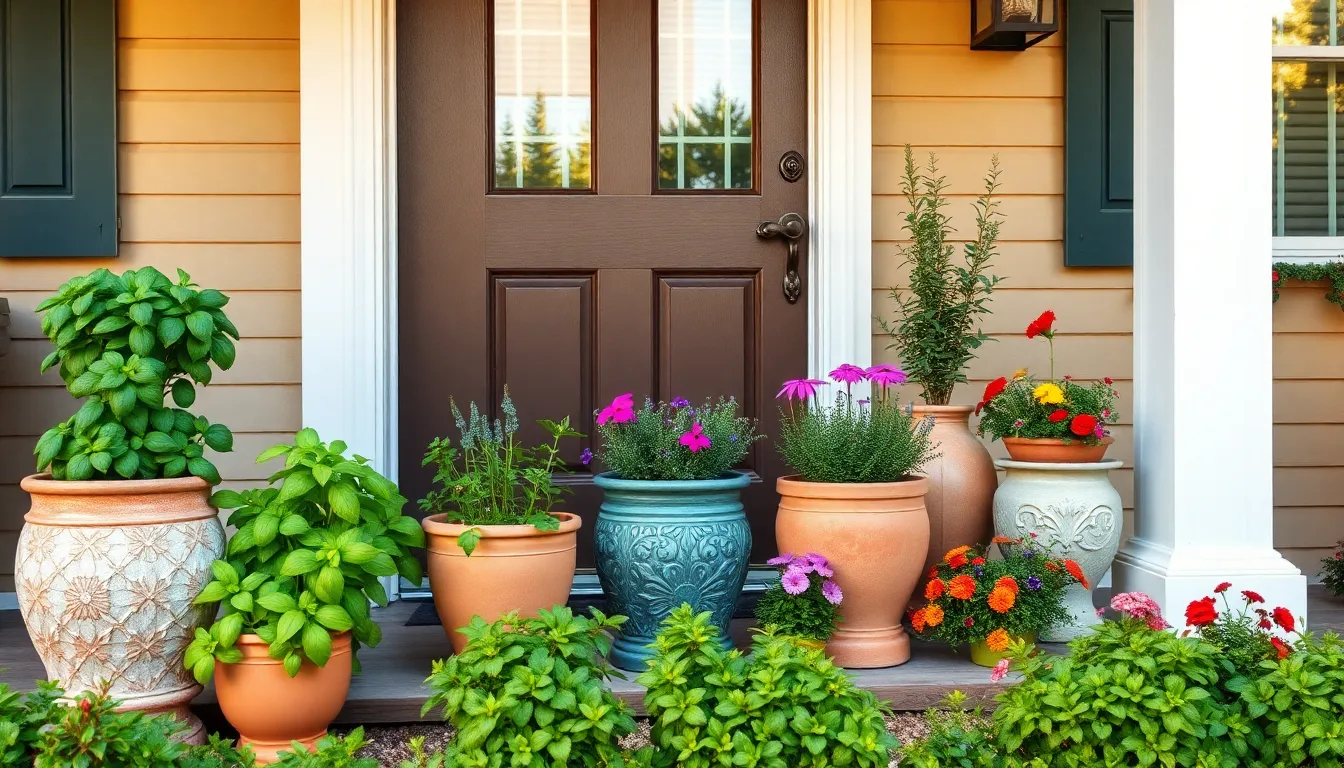
Fresh herbs become instantly accessible when we position gardens right outside our front doors. Convenience meets functionality as we harvest basil, thyme, rosemary, and oregano within steps of our kitchens.
Culinary Herb Containers
Attractive containers transform our herb growing experience while improving porch aesthetics. Rustic terracotta pots offer classic charm, while decorative concrete planters provide modern sophistication for our culinary herbs. We can mix herbs with colorful edible flowers like nasturtiums to create vibrant, eye-catching arrangements that serve dual purposes.
Strategic placement amplifies both function and visual appeal. Symmetrical positioning beside our front doors creates welcoming atmospheres, while containers arranged along steps enhance curb appeal naturally. We control soil quality and drainage more effectively through container gardening, ensuring our herbs thrive in optimal growing conditions.
Aromatic Plant Selections
Lavender brings delightful fragrance while naturally repelling pests from our porch spaces. Mint varieties offer fresh scents and culinary versatility, creating sensory pleasure every time we pass by our gardens. Lemon balm provides citrusy aromatics that attract beneficial pollinators to our front yard ecosystems.
Scented geraniums add ornamental beauty alongside their pleasant fragrances. We can combine these aromatic herbs with ornamental flowers like lantanas and coneflowers to add texture and seasonal color. This mixture enriches our front porch experience by captivating multiple senses throughout different growing seasons.
Kitchen Garden Accessibility
Raised herb boxes positioned at waist height minimize bending and maximize harvesting ease for our daily cooking needs. We arrange frequently used herbs closest to our doors to encourage regular use and maintain convenient access. Smart positioning ensures plants receive adequate sunlight without obstructing windows or doorways.
Visual harmony maintains functionality when we select plants that complement our home’s exterior design. Thoughtful plant placement creates seamless integration between our kitchen gardens and outdoor living spaces. We transform our porches into lively, fragrant extensions of our kitchens through strategic accessibility planning.
Low-Maintenance Succulent Arrangements
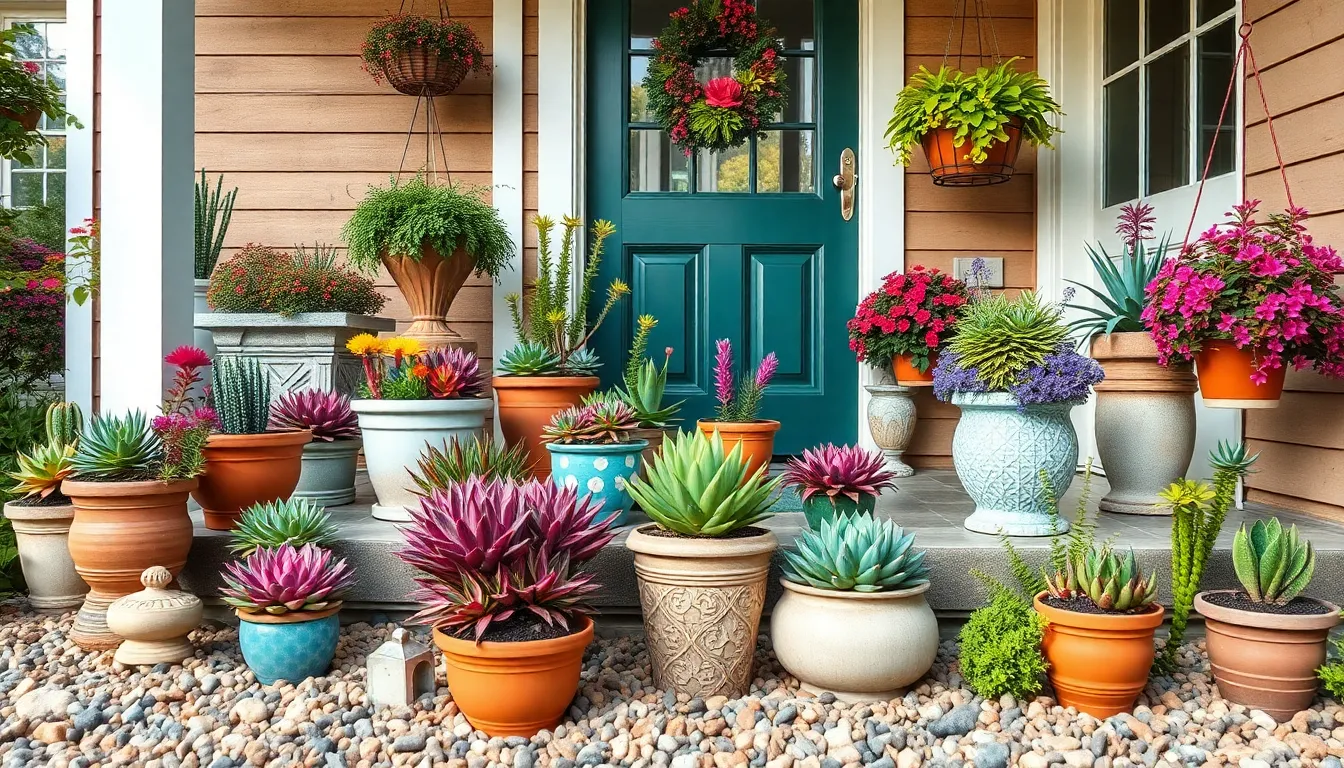
Succulents offer the perfect solution for busy homeowners who want beautiful front porch gardens without constant maintenance demands. These resilient plants create stunning displays while requiring minimal care and attention.
Drought-Tolerant Plant Options
Sedum varieties lead our recommendations for porch succulent gardens because they thrive in containers and handle drought conditions exceptionally well. These hardy plants can survive extended periods without water, making them ideal for hot or dry climates where traditional flowers struggle.
Perennial options expand your low maintenance choices beyond traditional succulents. Catmint and coreopsis flourish in full sun locations, delivering vibrant colors throughout growing seasons. Heuchera and dicentra work wonderfully in part sun areas, providing textural interest and seasonal foliage changes.
Zone compatibility becomes crucial when selecting outdoor succulents for year round placement. We recommend choosing plants hardy to your exact USDA zone to ensure they survive winter temperatures without protection or indoor storage.
Creative Container Ideas
Self watering containers revolutionize succulent care by reducing watering frequency to weekly intervals or less. These innovative planters maintain consistent moisture levels while preventing the overwatering that often kills succulent arrangements.
Window boxes filled with seasonal succulents provide continuous color changes throughout the year. We can swap out different varieties as desired, creating fresh looks that complement changing seasons and personal preferences.
Hanging baskets add vertical dimension to front porch displays while requiring minimal floor space. These elevated arrangements create layered garden effects that draw the eye upward and maximize growing area in compact porch settings.
Minimal Watering Requirements
Gravel and river rock gardens eliminate watering and fertilizing needs entirely while creating striking visual displays. These stone arrangements provide excellent drainage for succulent roots and reflect heat to create ideal growing conditions.
Artificial turf installations deliver lush green appearances without any watering requirements. This maintenance free option provides consistent color and texture that complements succulent containers year round.
Mulch applications help retain soil moisture and reduce watering frequency for planted arrangements. Organic mulches break down over time to improve soil conditions while decorative stones provide permanent moisture retention benefits.
Edible Front Porch Gardens

Fresh produce right outside your front door transforms both curb appeal and daily cooking routines. Edible gardens create functional beauty that nourishes families while impressing neighbors.
Compact Vegetable Containers
Compact Vegetable Containers maximize growing potential in minimal porch space. Cherry tomatoes thrive in small pots, producing abundant harvests throughout the growing season. Leafy greens like lettuce, spinach, and arugula flourish in shallow planters and provide continuous harvests when succession planted. Herbs such as basil, thyme, and oregano make excellent choices for beginning container gardeners.
Moveable containers offer flexibility to optimize sunlight exposure throughout the day. We recommend wheeled plant caddies for heavier pots, allowing easy repositioning as sun patterns change. Space efficient arrangements use vertical growing by stacking smaller containers on plant stands or shelves.
Proper container sizing ensures healthy root development and productive yields. Most compact vegetables require containers at least 6-8 inches deep, while tomatoes need 12-inch minimum depths. Drainage holes prevent root rot and maintain optimal soil moisture levels.
Berry Bushes in Pots
Berry Bushes in Pots deliver sweet rewards while adding ornamental value to front porch displays. Strawberries adapt exceptionally well to container growing and produce fruit within the first year of planting. Dwarf blueberry varieties like ‘Top Hat’ and ‘Sunshine Blue’ stay compact while producing full sized berries.
Large containers accommodate berry bush root systems and support long term growth. We suggest using pots at least 18-20 inches wide for most berry varieties. Acidic soil conditions benefit blueberries and cranberries, requiring specialized potting mixes or soil amendments.
Raspberry varieties like ‘Red River’ and ‘Shortcake’ work well in containers and offer space saving alternatives to traditional garden patches. Year round interest comes from berry blossoms in spring, fruit production in summer, and colorful foliage changes in fall.
Microgreen Growing Systems
Microgreen Growing Systems provide nutrient dense harvests in minimal space and time. These young vegetables contain concentrated vitamins and minerals while offering intense flavors for culinary applications. Shallow trays only 1-2 inches deep accommodate most microgreen varieties.
Continuous harvests result from succession planting new trays every 7-10 days. Radish, pea, and sunflower microgreens mature within 7-14 days from seed to harvest. Indoor outdoor flexibility allows moving trays between porch and kitchen based on weather conditions.
Simple growing requirements make microgreens perfect for beginning gardeners. Seeds need only water, growing medium, and indirect sunlight to produce abundant harvests. Vertical systems use tiered shelving to multiply growing capacity without expanding floor space footprint.
Shade-Loving Plants for Covered Porches

Covered porches present unique opportunities for beautiful gardens that thrive without direct sunlight. We’ve discovered that shade tolerant plants can create stunning displays that rival any sun loving garden.
Fern and Foliage Combinations
Ferns serve as the foundation for elegant shade gardens with their diverse textures and forms. Boston ferns offer classic appeal with their graceful fronds, while maidenhair ferns provide delicate beauty through their intricate leaves. Japanese painted ferns add silvery accents that brighten darker corners of your porch.
Pairing ferns with hostas creates impressive layered displays that showcase varying leaf sizes and colors. Caladiums bring tropical flair with their heart shaped leaves in pink, white, and green combinations. Coral bells complement ferns beautifully with their colorful foliage that ranges from burgundy to chartreuse.
These foliage combinations remain visually striking throughout the entire growing season while requiring minimal maintenance. Watering consistently and providing good drainage keeps these partnerships thriving in shaded conditions.
Begonia and Impatiens Displays
Begonias deliver continuous summer color with their waxy leaves and abundant blooms in pink, red, orange, and white shades. These reliable performers flourish in partial shade while producing flowers from spring until the first frost. Regular deadheading encourages more blooms and keeps plants looking fresh.
Impatiens excel in hanging baskets positioned near porch seating areas where their prolific flowers create cascading color displays. Their wide range of available colors allows you to match any design scheme or personal preference. Both plants require moist soil conditions to perform at their best.
Combining begonias and impatiens in mixed containers creates ever-changing arrangements that provide varying heights and textures. Positioning taller begonias in the center with trailing impatiens around the edges maximizes visual impact in limited space.
Coleus Color Schemes
Coleus plants are prized for their vivid, patterned leaves that combine purple, green, yellow, and red in striking patterns. These shade loving plants thrive without direct sunlight while providing dramatic color contrast throughout the growing season. Their foliage serves as living artwork that changes subtly as plants mature.
Using coleus as standalone features in decorative containers creates bold focal points on covered porches. Mixing different coleus varieties together produces spectacular displays that rival any flowering arrangement. Pairing coleus with flowering plants like begonias adds another layer of visual interest.
Combining coleus with textured foliage plants creates sophisticated arrangements that showcase both color and form. Their low maintenance requirements make them perfect for busy homeowners who want maximum impact with minimal effort.
Fragrant Gardens That Enhance Curb Appeal
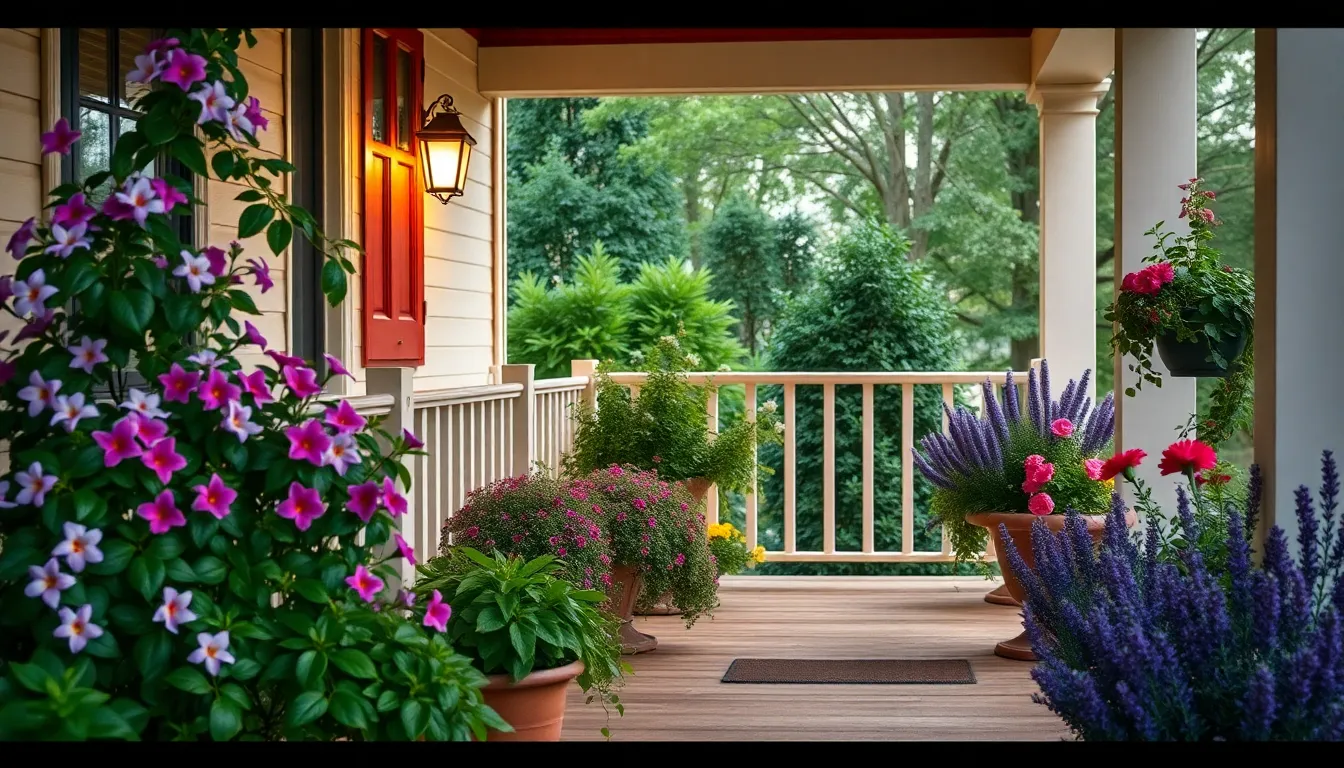
Fragrant plants transform your front porch into a sensory experience that delights visitors before they even reach your door. We’ll explore how strategic scent placement creates memorable first impressions while boosting your home’s curb appeal.
Evening Scented Plants
Evening primrose releases its sweet fragrance as temperatures cool and daylight fades. We recommend positioning jasmine in larger containers near seating areas where guests can fully appreciate its intoxicating scent during twilight hours. Honeysuckle vines work beautifully when trained along porch railings, creating cascading walls of fragrance that intensify throughout the evening.
Plant these evening bloomers in spots where you’ll spend time after dinner or during quiet evening moments. We suggest grouping them with subtle lighting to highlight their beauty while their fragrances peak. Strategic placement near entryways ensures visitors experience these welcoming scents as they approach your home during evening gatherings.
Morning Fragrance Options
Roses provide classic morning fragrance that pairs beautifully with your first cup of coffee on the porch. We love placing lavender in rectangular planters along porch steps where morning foot traffic releases its calming essential oils. Gardenias offer intense sweetness that’s most pronounced in cooler morning air before heat diminishes their potency.
Position these morning bloomers where early sunlight enhances their fragrance release. We recommend creating layered arrangements with taller gardenias in back and lower lavender borders in front for maximum scent distribution. Morning scented plants work exceptionally well near breakfast nooks or coffee stations on covered porches.
Pollinator Friendly Selections
Coneflowers attract beneficial bees while providing purple and pink blooms that complement other fragrant plantings. We suggest incorporating black eyed Susans for their bright yellow flowers that create stunning contrast against evening scented jasmine. Sunflowers make bold statements in large containers while drawing pollinators that support your entire garden network.
Butterfly attracting zinnias offer vibrant colors in red, orange, and yellow that create visual excitement alongside subtle fragrant plants. We recommend planting marigolds around the base of larger containers for their pest deterrent properties and cheerful blooms. Lantana provides continuous flowering throughout warm months while attracting both butterflies and beneficial insects that enhance your garden’s health.
Budget-Friendly DIY Planter Projects
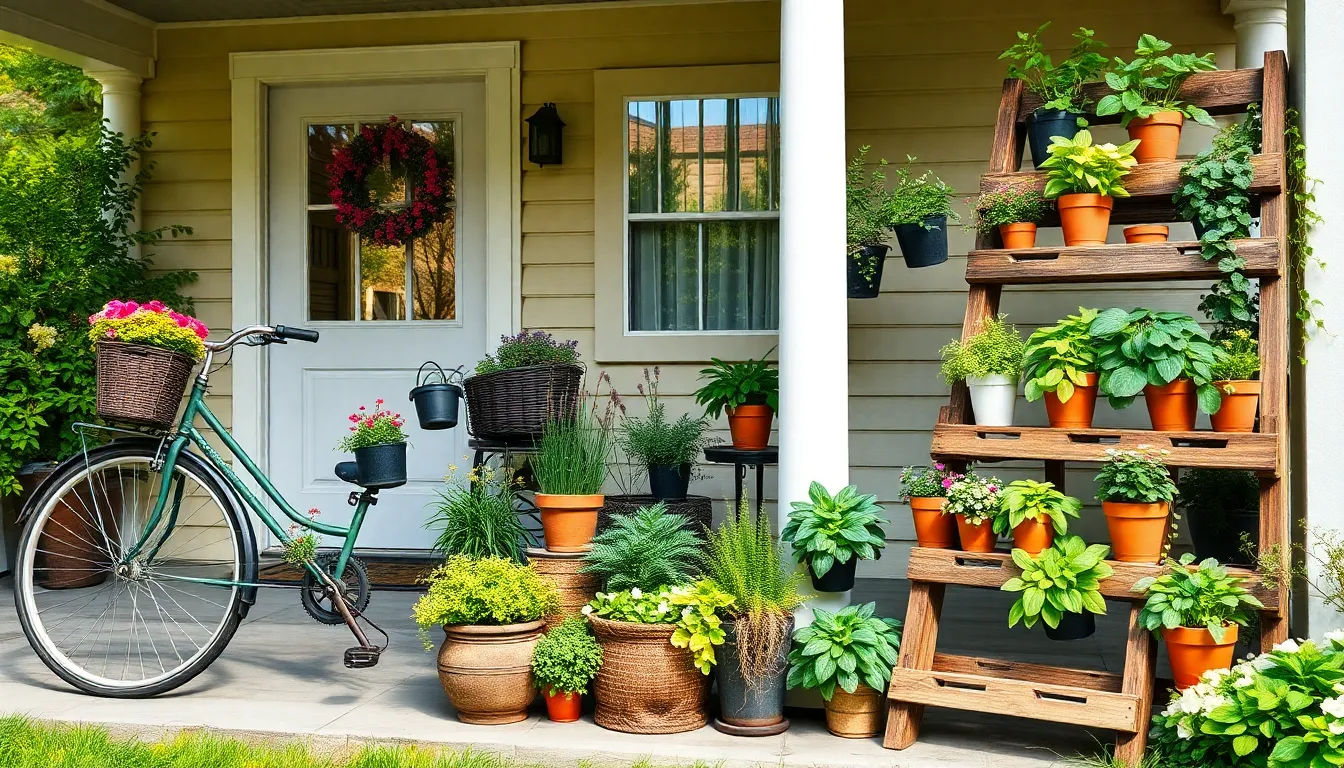
Creating stunning front porch gardens doesn’t require expensive investments when you embrace creative DIY answers. We’ll show you how to transform everyday items into beautiful planters that rival costly store-bought alternatives.
Repurposed Container Ideas
Old bikes become charming garden centerpieces when we attach pots to their frames and position them strategically on porches. Transform your vintage bicycle into a conversation starter by securing planters to the basket, handlebars, and rear rack for a whimsical display.
Broken terracotta pots offer endless possibilities for creating enchanting fairy gardens that capture children’s imaginations. Stack the damaged pieces artistically to form miniature landscapes, then tuck small plants like moss and baby ferns into the crevices.
Wooden pallets serve as excellent vertical growing systems when we secure small containers between their slats. Paint them in colors that complement your home’s exterior, then fill each opening with herbs or trailing plants for maximum visual impact.
Old ladders provide instant tiered planting opportunities that maximize vertical space beautifully. Position them against porch walls and place potted plants on each rung, creating a cascading garden effect that draws the eye upward.
Homemade Plant Stands
Pallet stands add rustic charm while elevating plants to perfect viewing heights throughout your porch space. Stack multiple pallets to create different levels, then sand and stain them to match your outdoor decor.
Ladder planters offer versatile display options when we paint them in weather-resistant finishes and arrange plants by height. Position taller plants on lower rungs and cascading varieties on upper levels to create natural visual flow.
Cinder block arrangements provide sturdy, customizable plant stands that cost just a fraction of commercial alternatives. Stack them in various configurations to create unique geometric patterns while providing excellent drainage through their hollow centers.
Wooden crate towers maximize growing space when we stack them at different angles for visual interest. Fill each crate with appropriate plants based on light requirements, ensuring top boxes receive more sun-loving varieties.
Creative Drainage Answers
Rock features enhance both drainage and aesthetic appeal when we incorporate them strategically into our planter designs. Layer different sized stones in container bottoms to prevent root rot while creating attractive textural elements.
Mulch and gravel combinations help absorb and redirect excess water while reducing maintenance requirements significantly. Spread organic mulch around plant bases, then add decorative gravel pathways to complete the professional look.
Drill holes in repurposed containers to ensure proper water flow and prevent plant damage from standing water. Space drainage holes every 2-3 inches across container bottoms, then cover with coffee filters to prevent soil loss.
Elevated platforms improve air circulation and drainage when we raise planters off porch surfaces using simple supports. Use wooden blocks, bricks, or plant saucers with feet to create adequate clearance beneath containers.
Year-Round Evergreen Arrangements
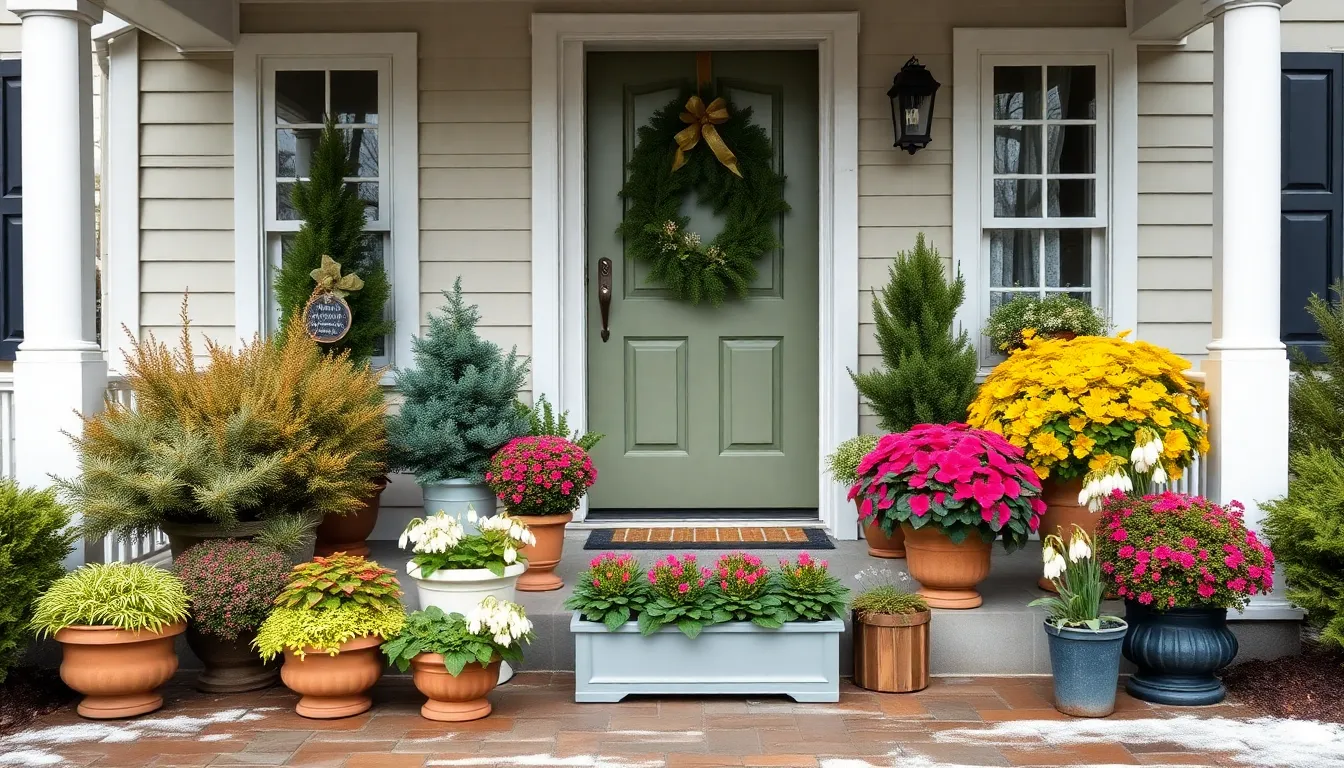
Creating a front porch display that maintains its beauty through every season requires strategic plant selection and thoughtful design. We’ll focus on evergreen options that provide consistent structure while adding visual interest throughout the year.
Winter Interest Plants
Winter flowering plants transform our front porches into captivating displays when most gardens lie dormant. Winter aconite brightens the coldest months with cheerful yellow blooms that push through snow, while snowdrops offer delicate white flowers that signal spring’s approach. We recommend planting these bulbs in clusters within containers for maximum visual impact.
Evergreen shrubs form the backbone of our winter arrangements, providing essential structure when deciduous plants lose their leaves. Boxwoods excel in this role because they require minimal maintenance and can be shaped to complement any porch design. We often position these versatile shrubs in corners or use them to frame doorways, creating natural focal points that enhance our home’s entrance.
Ornamental grasses add movement and texture to winter displays, swaying gracefully in cold breezes while maintaining their architectural form. We pair these grasses with low growing groundcovers to create layered arrangements that remain interesting even under snow cover.
Dwarf Conifer Selections
Dwarf blue spruce stands out as our top choice for compact evergreen beauty, offering vibrant blue green foliage that creates stunning contrast against winter backgrounds. This cold hardy specimen maintains its distinctive color year round and fits perfectly in containers without overwhelming smaller porch spaces.
Dwarf mugo pine provides reliable structure with minimal care requirements, making it ideal for busy homeowners seeking low maintenance answers. We appreciate how this compact variety retains its attractive form throughout all seasons while tolerating harsh weather conditions that challenge other plant selections.
Container plantings benefit from mixing different conifer species to create visual depth and interest. We combine junipers with cedars and dwarf spruce varieties to establish varied textures and heights within our arrangements. These combinations work especially well in large containers where we can showcase multiple specimens together.
Cold-Hardy Container Options
Succulents thrive in containers throughout cold seasons, particularly in drier climates where they can tolerate temperature fluctuations better than traditional flowering plants. We select varieties like sedum and hens and chicks that withstand freezing temperatures while maintaining their attractive appearance.
Large containers allow us to create sophisticated mixed plantings that combine evergreen species with textural accents. We fill these vessels with junipers or cedars as anchor plants, then add ornamental grasses and hardy groundcovers to complete our year round displays.
Weather resistant container materials ensure our arrangements survive harsh winter conditions without cracking or deteriorating. We choose concrete, fiberglass, or high quality resin planters that maintain their appearance through freeze thaw cycles while providing adequate drainage for healthy root systems.
Conclusion
We’ve shown you how front porch gardens can transform your home’s entrance into a welcoming oasis that reflects your personal style. From simple container arrangements to elaborate vertical displays these gardens offer endless possibilities for every skill level and budget.
The beauty of front porch gardening lies in its flexibility. Whether you’re drawn to fragrant herbs low-maintenance succulents or colorful seasonal displays you can create a space that works for your lifestyle. DIY projects and repurposed materials make beautiful gardens accessible to everyone.
Your front porch garden becomes more than decoration—it’s an extension of your home that greets visitors and provides daily joy. With the right plant choices and creative arrangements you’ll enjoy a thriving garden space that enhances your curb appeal year-round.
Frequently Asked Questions
What are the main benefits of having a front porch garden?
Front porch gardens are easier to maintain than traditional gardens, provide immediate visual impact to enhance curb appeal, and create an inviting first impression for visitors. They also foster an indoor-outdoor living experience, making your home feel more welcoming and connected to nature.
Can beginners create beautiful front porch gardens?
Absolutely! Anyone can create a stunning front porch garden regardless of gardening experience. The key is choosing the right plants for your local climate and following basic design principles. Start small with easy-care plants and gradually expand as you gain confidence.
What is the “thriller, filler, spiller” planting technique?
This popular container gardening method uses three types of plants: a “thriller” (tall, eye-catching plant in the center), “fillers” (medium-height plants around the thriller), and “spillers” (trailing plants that cascade over container edges). This creates visual depth and professional-looking arrangements.
How can I maximize space on a small front porch?
Utilize vertical growing solutions like wall-mounted planters, trellises for climbing plants, tiered plant stands, and ladder-style displays. Hanging baskets also add greenery without taking up floor space. These methods transform cramped areas into flourishing garden displays.
What plants work best for shaded front porches?
Shade-loving plants like ferns, hostas, caladiums, begonias, impatiens, and coleus thrive in covered porches without direct sunlight. These plants create stunning displays with minimal maintenance while adding color and texture to darker areas.
How do I maintain year-round curb appeal?
Create seasonal displays by rotating plants throughout the year. Use spring bulbs, summer heat-lovers, fall mums with gourds, and winter evergreens. Incorporate evergreen elements like boxwoods and dwarf conifers to provide structure during colder months.
What are good low-maintenance plants for busy homeowners?
Succulents, drought-tolerant plants like sedum and coreopsis, and self-watering containers are perfect for busy schedules. Consider gravel gardens that require no watering, or use mulch to retain soil moisture and reduce maintenance needs.
Can I grow edible plants on my front porch?
Yes! Compact vegetables like cherry tomatoes and leafy greens, potted berry bushes, herbs, and microgreens all work well in front porch containers. These provide fresh ingredients for cooking while enhancing your home’s curb appeal.
What fragrant plants are best for front porches?
Evening-scented plants like jasmine and honeysuckle are perfect near seating areas. Morning fragrance options include roses and lavender. Pollinator-friendly plants like coneflowers and zinnias add fragrance while attracting beneficial insects to your garden.
How can I create attractive planters on a budget?
Repurpose everyday items like old bikes, broken terracotta pots for fairy gardens, wooden pallets, and ladders for vertical displays. Use homemade plant stands and creative drainage solutions. With thoughtful planning, you can create beautiful displays without spending much money.

